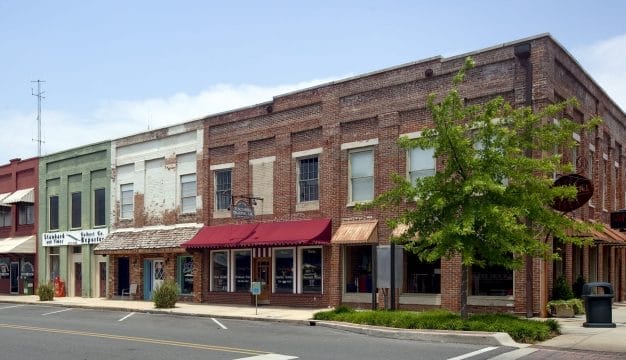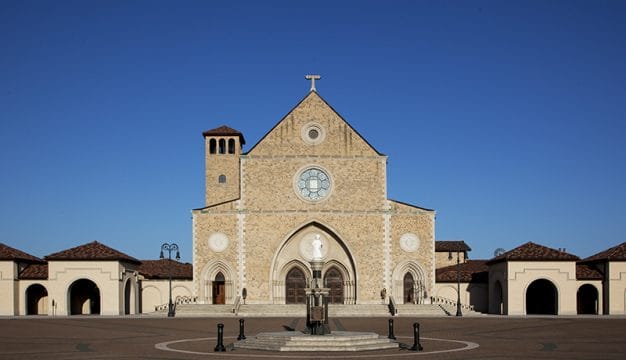Ozark
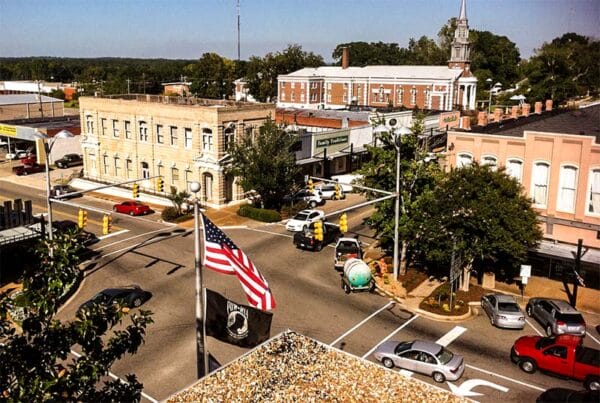 Downtown Ozark
Ozark is the seat of Dale County and is located in the southeast corner of Alabama in the region of the state known as the Wiregrass. According to local lore, the city received its name from a traveler who thought that the terrain looked like that of the Ozark Mountains in Arkansas. Ozark has a mayor-council form of government and borders Fort Novosel, the center of U.S. Army aviation.
Downtown Ozark
Ozark is the seat of Dale County and is located in the southeast corner of Alabama in the region of the state known as the Wiregrass. According to local lore, the city received its name from a traveler who thought that the terrain looked like that of the Ozark Mountains in Arkansas. Ozark has a mayor-council form of government and borders Fort Novosel, the center of U.S. Army aviation.
History
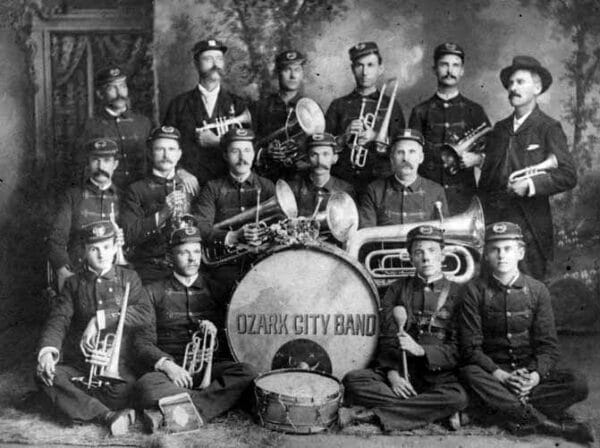 Ozark City Band, ca. 1890
Before their forced removal, the area that now includes Ozark was part of the Creek Nation. The first documented white settler was John Merrick Sr., a Revolutionary War veteran, who built a cabin on land that is now downtown Ozark in 1822. The settlement thus came to be known initially as Merricks. In 1826, Rev. Dempsey Dowling moved to the area, and his family established the Claybank Church in 1829-30; the current structure, the second on the site, was built in 1856 and is among the oldest log structures in the region. The first municipal water plant opened in 1840 and the first school was established in 1841. Two years later, the town’s name was changed to Woodshop in honor of an important local woodworking business. The town’s name was changed to Ozark in the mid-1850s.
Ozark City Band, ca. 1890
Before their forced removal, the area that now includes Ozark was part of the Creek Nation. The first documented white settler was John Merrick Sr., a Revolutionary War veteran, who built a cabin on land that is now downtown Ozark in 1822. The settlement thus came to be known initially as Merricks. In 1826, Rev. Dempsey Dowling moved to the area, and his family established the Claybank Church in 1829-30; the current structure, the second on the site, was built in 1856 and is among the oldest log structures in the region. The first municipal water plant opened in 1840 and the first school was established in 1841. Two years later, the town’s name was changed to Woodshop in honor of an important local woodworking business. The town’s name was changed to Ozark in the mid-1850s.
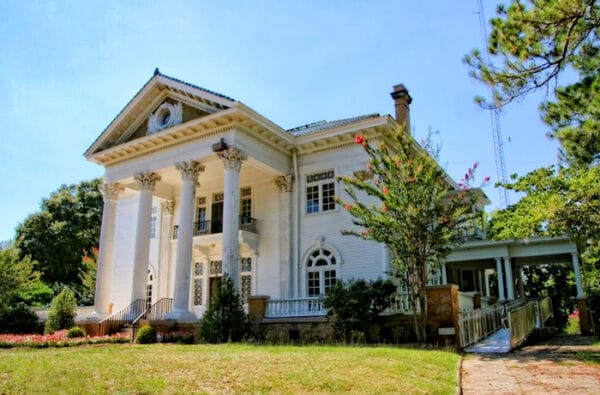 J. D. Holman House
When Dale County was established in 1824, the town of Daleville was named as county seat. The county seat was moved to Newton in 1843, but when the courthouse there burned down in 1869, county officials held an election to choose a new site for the county seat. Ozark won and was incorporated as a town on October 27, 1870. That same year, Ozark’s weekly newspaper, The Southern Star, began publication and continues to the present. In 1888, the Central of Georgia Railroad completed a line connecting Eufaula, a center of shipping, to Ozark, and the Alabama Midland Railroad completed a connector line to Troy the following year. In 1914, the Mutual Cotton Oil Company, originally called the Ozark Oil Mill, began processing cotton-seed oil for commercial use. By this time, however, the boll weevil had begun to devastate cotton crops in the area, and Ozark’s agricultural output began to diversify to include livestock, peanuts, and other commodities.
J. D. Holman House
When Dale County was established in 1824, the town of Daleville was named as county seat. The county seat was moved to Newton in 1843, but when the courthouse there burned down in 1869, county officials held an election to choose a new site for the county seat. Ozark won and was incorporated as a town on October 27, 1870. That same year, Ozark’s weekly newspaper, The Southern Star, began publication and continues to the present. In 1888, the Central of Georgia Railroad completed a line connecting Eufaula, a center of shipping, to Ozark, and the Alabama Midland Railroad completed a connector line to Troy the following year. In 1914, the Mutual Cotton Oil Company, originally called the Ozark Oil Mill, began processing cotton-seed oil for commercial use. By this time, however, the boll weevil had begun to devastate cotton crops in the area, and Ozark’s agricultural output began to diversify to include livestock, peanuts, and other commodities.
Agriculture remained the most important segment of Ozark’s economy until the outbreak of World War I and the establishment of Camp Rucker. Later called Fort Rucker and renamed Fort Novosel in 2023, the installation is the home of Army Aviation and the newly formed U.S. Army Warrant Officer Career Center. The fort remains a primary driver of Ozark’s economy. During the 1990s, Ozark opened the Dale County Agricultural Complex and the High Technology Center to broaden its economy.
Demographics
According to 2020 Census estimates, Ozark recorded a population of 14,350. Of that number, 61.5 percent identified themselves as white, 31.2 percent as African American, 6.5 percent as Hispanic, 2.4 percent as two or more races, 1.8 percent as Asian, and 1.0 percent as Native American. The city’s median household income was $41,894, and per capita income was $23,671.
Employment
According to 2020 Census estimates, the workforce in Ozark was divided among the following industrial categories:
- Educational services, and health care and social assistance (20.8 percent)
- Retail trade (18.5 percent)
- Transportation and warehousing and utilities (13.1 percent)
- Manufacturing (8.4 percent)
- Arts, entertainment, recreation, accommodation, and food services (7.4 percent)
- Professional, scientific, management, and administrative and waste management services (7.4 percent)
- Public administration (7.4 percent)
- Construction (6.4 percent)
- Other services, except public administration (4.7 percent)
- Finance, insurance, and real estate, rental, and leasing (2.9 percent)
- Wholesale trade (1.5 percent)
- Agriculture, forestry, fishing and hunting, and extractive (1.2 percent)
- Information (0.2 percent)
Education
The Ozark City School System includes one early childhood school, two elementary schools, a middle school, and a high school. In addition to the public schools, Ozark is home to three private schools. Coastal Alabama Community College maintains a branch campus in Ozark that focuses on instruction and training relating to aviation maintenance, targeted toward jobs in the U.S. Army’s aviation programs at Fort Novosel.
Transportation
Ozark is served by U.S. Highway 231, which runs north-south and connects with Ozark via State Highway 27. Residents are served by two airports: Blackwell Field Airport, which is for general aviation, and Cairns AAF Airport, which is connected to Fort Novosel. CSX Rail serves the city for rail transportation.
Events and Places of Interest
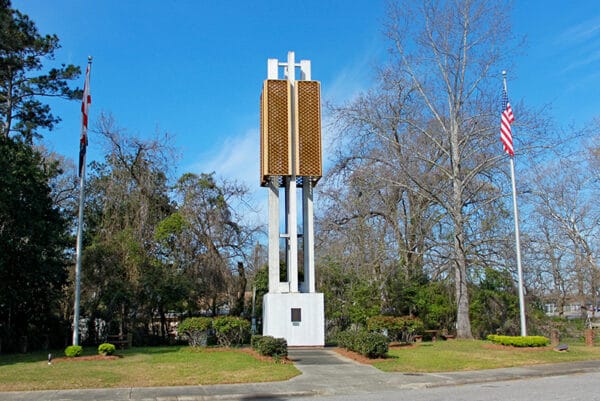 Carillon and Bell Tower
The city of Ozark offers visitors a number of recreational and educational opportunities, including several sports facilities and recreation centers. The historic Claybank Church and Cemetery and the Confederate Monument, both erected in the mid-nineteenth century, offer visitors an opportunity to experience Ozark history, as does a walk down historic Broad Street, which is lined with antebellum buildings. The J. D. Holman House, built in 1912-13, is a noted example of the Neoclassical style of architecture. It was added to the National Register of Historic Places in 1982 and serves as an event center. Sam Dale Park and Monument honor Alabama pioneer and military figure Samuel Dale, who is best known for his part in the legendary Canoe Fight during the Creek War of 1813-14. The county’s veterans are honored with the Carillon and Bell Tower memorial, which is dedicated to those who have served at Fort Novosel.
Carillon and Bell Tower
The city of Ozark offers visitors a number of recreational and educational opportunities, including several sports facilities and recreation centers. The historic Claybank Church and Cemetery and the Confederate Monument, both erected in the mid-nineteenth century, offer visitors an opportunity to experience Ozark history, as does a walk down historic Broad Street, which is lined with antebellum buildings. The J. D. Holman House, built in 1912-13, is a noted example of the Neoclassical style of architecture. It was added to the National Register of Historic Places in 1982 and serves as an event center. Sam Dale Park and Monument honor Alabama pioneer and military figure Samuel Dale, who is best known for his part in the legendary Canoe Fight during the Creek War of 1813-14. The county’s veterans are honored with the Carillon and Bell Tower memorial, which is dedicated to those who have served at Fort Novosel.
The annual Claybank Jamboree, held every October, includes antiquing, an art show, and a 5K run. Ed Lisenby Lake is known as the top lake for bass fishing in the state, as well as offering other game fish. Mabson Community Education Forest features interpretive walking trails and various stations focusing on forestry and conservation. Nearby attractions include the U.S. Army Aviation Museum and Lake Tholocco on the campus of Fort Novosel.
Further Reading
- Heritage of Dale County. Clanton, Ala.: Heritage Publishing Consultants, 2003.
